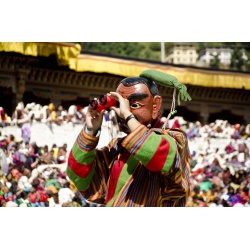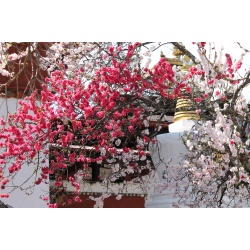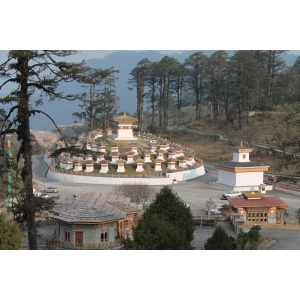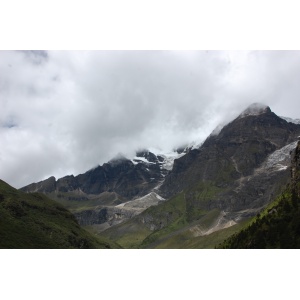Bhutan is an enchanting tourist destination renowned for its unspoiled natural beauty, rich cultural heritage, and commitment to sustainable development through the philosophy of Gross National Happiness. Here are some key aspects that make Bhutan a unique and compelling destination for travelers:

- Pristine Landscapes: Bhutan's landscape is characterized by majestic mountains, lush valleys, pristine rivers, and dense forests. The country's commitment to environmental conservation ensures that much of its natural beauty remains untouched.
-
Unique Culture and Tradition: Bhutanese culture is deeply rooted in Buddhism, and the country is dotted with monasteries, stupas, and dzongs (fortress-monasteries) that are not only religious sites but also architectural marvels. The people of Bhutan maintain their traditional way of life, including vibrant festivals, intricate artwork, and colorful attire.
-
Tiger's Nest Monastery: The iconic Tiger's Nest Monastery, perched on a cliffside in Paro Valley, is one of Bhutan's most famous landmarks. Its breathtaking location and spiritual significance make it a must-visit destination for tourists.
-
Gross National Happiness (GNH): Bhutan prioritizes the happiness and well-being of its citizens over economic growth, as reflected in its unique development philosophy of Gross National Happiness. Visitors can experience this emphasis on holistic well-being through interactions with locals, serene environments, and sustainable tourism initiatives.
-
Adventure and Trekking: Bhutan offers excellent opportunities for adventure enthusiasts, including trekking, mountain biking, and white-water rafting. Popular trekking routes such as the Snowman Trek and the Druk Path Trek allow travelers to explore remote regions and witness stunning landscapes.
-
Cultural Festivals: Bhutan celebrates numerous colorful festivals throughout the year, known as Tsechus. These festivals feature traditional masked dances, music, and religious rituals, providing visitors with an immersive cultural experience.
-
Sustainable Tourism: Bhutan has adopted a high-value, low-impact tourism model to preserve its natural and cultural heritage. The government regulates tourism through a "Minimum Daily Package" that includes accommodation, meals, transportation, and a sustainable tourism fee, ensuring that tourism benefits local communities and supports conservation efforts.
Some of the attraction or places you must visit while in Bhutan.
One of the top attractions in Bhutan for tourists is the stunning Tiger's Nest Monastery, also known as Paro Taktsang.

Perched precariously on the edge of a cliff, this iconic monastery is not only a significant religious site but also offers breathtaking views of the surrounding mountains and valleys. Visitors can embark on a challenging hike to reach the monastery, passing through lush forests and enjoying the serene atmosphere along the way. Paro Taktsang stands as a testament to Bhutan's rich cultural heritage and offers visitors a glimpse into the country's deep-rooted spiritual traditions.
Punakha Dzong
Punakha Dzong, also known as Pungtang Dechen Photrang Dzong (meaning "the palace of great happiness or bliss"), is one of the most majestic and significant dzongs (fortress-monasteries) in Bhutan. Located at the confluence of the Pho Chhu (Father River) and Mo Chhu (Mother River) in the Punakha Valley, it served as the capital of Bhutan until the 1950s. Here are some key features and historical aspects of Punakha Dzong:
-
Architectural Marvel: Punakha Dzong is renowned for its remarkable architecture, which exemplifies traditional Bhutanese craftsmanship and design. Constructed without the use of nails, it is a masterpiece of woodwork, stonework, and whitewashed walls adorned with intricate Bhutanese motifs.
-
Historical Significance: Built in 1637 by Zhabdrung Ngawang Namgyal, the founder of Bhutan, Punakha Dzong has played a crucial role in the history of the country. It has served as the winter residence of the clergy and the central administrative hub of the government.
-
Religious Importance: The dzong houses sacred relics and serves as a center for religious and cultural ceremonies. It is the winter residence of the Je Khenpo (the Chief Abbot of Bhutan) and hosts the annual Punakha Tshechu, a colorful festival featuring masked dances, religious rituals, and celebrations.
Thimphu
Thimphu, the capital city of Bhutan, holds significant importance for several reasons:

-
Administrative Center: Thimphu serves as the administrative, political, economic, and cultural hub of Bhutan. It is home to the country's government institutions, including the Royal Palace, the National Assembly, and various ministries and government offices.
-
Cultural Heart: Despite its status as a rapidly developing city, Thimphu has managed to preserve Bhutanese culture and traditions. Visitors can experience Bhutanese architecture, arts, crafts, and cuisine in Thimphu. The city hosts various cultural events, including traditional festivals (Tsechus) and religious ceremonies, offering visitors insights into Bhutan's rich cultural heritage.
-
Spiritual Center: Thimphu boasts numerous religious sites, including monasteries, temples, and stupas, making it a spiritual center in Bhutan. One of the most significant religious sites is Tashichho Dzong, which serves as both a fortress and a monastery and houses important religious relics and administrative offices.
-
Educational Hub: Thimphu is home to Bhutan's most prestigious educational institutions, including the Royal University of Bhutan and several colleges and schools. The city's educational facilities attract students from across the country, contributing to its role as an educational hub.
-
Commercial Center: Thimphu is Bhutan's largest city and the primary commercial center of the country. It hosts bustling markets, shops, and business establishments, offering a range of goods and services. Tourists can explore the city's markets to purchase traditional Bhutanese handicrafts, textiles, and souvenirs.
-
Tourist Destination: As the capital city, Thimphu attracts a significant number of tourists who come to explore its attractions, including cultural landmarks, museums, art galleries, and scenic viewpoints. Visitors can also engage in outdoor activities such as hiking, cycling, and birdwatching in the surrounding areas.
Dochula Pass
Dochula Pass is a scenic mountain pass located on the road from Thimphu to Punakha in Bhutan. It sits at an elevation of approximately 3,100 meters (10,200 feet) above sea level and is renowned for its breathtaking panoramic views of the Himalayan mountain range, including on clear days the majestic peaks of the Bhutanese Himalayas. Here are some key aspects and significance of Dochula Pass:
-
Spectacular Views: The primary attraction of Dochula Pass is undoubtedly the stunning vistas it offers of the snow-capped peaks of the Himalayas. On a clear day, visitors can enjoy panoramic views of prominent peaks such as Gangkar Puensum, the highest mountain in Bhutan, as well as Masagang, Tsenda Kang, and Teri Kang.
-
108 Chortens: One of the notable features of Dochula Pass is the presence of 108 chortens or stupas, known as Druk Wangyal Chortens, built in memory of Bhutanese soldiers who lost their lives in a military operation against insurgents from India in 2003. These white-washed chortens add to the spiritual ambiance of the pass and serve as a symbol of peace and prosperity.
-
Spiritual Significance: Apart from the memorial chortens, Dochula Pass is also considered a sacred site in Bhutanese culture. It is believed to be an important meditation spot for both locals and travelers, offering a serene environment amidst the natural beauty of the Himalayas.
-
Rest Stop and Picnic Area: Due to its strategic location between Thimphu and Punakha, Dochula Pass serves as a popular rest stop for travelers journeying between the two cities. The pass is equipped with facilities such as a cafeteria, restrooms, and picnic spots, allowing visitors to relax and enjoy the scenic surroundings.
-
Cultural Experience: Dochula Pass provides visitors with an opportunity to experience Bhutanese culture and traditions, as it is often visited by locals and tourists alike. Visitors can witness traditional prayer flag ceremonies, perform circumambulations around the chortens, and soak in the peaceful atmosphere of the pass.
Rinpung Dzong
Paro Rinpung Dzong is a prominent fortress-monastery located in the Paro Valley of Bhutan. Here are some key aspects and significance of Paro Rinpung Dzong:

-
Historical Importance: Paro Rinpung Dzong was built in 1644 by Zhabdrung Ngawang Namgyal, the unifier of Bhutan. It has served as both a fortress to defend against invasions and as a monastery for religious and spiritual activities.
-
Architectural Grandeur: The dzong is renowned for its impressive architecture, characterized by towering whitewashed walls, wooden galleries, and intricately carved wooden windows and doors. It exemplifies traditional Bhutanese architectural style and craftsmanship.
-
Cultural Center: Paro Rinpung Dzong is a significant center of Bhutanese culture and religion. It houses various administrative offices, including the district administration office and the monastic body. The dzong also hosts religious festivals, ceremonies, and rituals throughout the year, attracting both locals and tourists.
-
Religious Significance: Within the dzong complex, there are several temples and shrines dedicated to Buddhist deities. The main temple, known as the Utse Lhakhang, enshrines a statue of Guru Rinpoche (Padmasambhava), the revered saint who introduced Buddhism to Bhutan.
-
Strategic Location: Situated on a hill overlooking the Paro Valley and the Paro River, Paro Rinpung Dzong occupies a strategic position. Its elevated location provided a defensive advantage against potential invasions, and the dzong played a crucial role in safeguarding the region.
-
Scenic Surroundings: The dzong offers stunning views of the surrounding landscape, including the Paro Valley, lush green hills, and snow-capped mountains in the distance. Its picturesque setting adds to its allure and makes it a popular destination for visitors.
-
Tourist Attraction: Paro Rinpung Dzong is one of the most visited tourist attractions in Bhutan. Visitors can explore the dzong's courtyards, temples, and administrative offices, as well as admire its architecture and learn about its history and cultural significance.
Buddha Dordenma Statue
The Buddha Dordenma Statue, located in Thimphu, Bhutan, is a magnificent monument and one of the tallest Buddha statues in the world. Here are some key aspects and significance of the Buddha Dordenma Statue:
-
Gigantic Statue: The Buddha Dordenma Statue stands at an impressive height of 51.5 meters (approximately 169 feet), making it one of the largest Buddha statues in the world. It is made of bronze and gilded in gold, adding to its grandeur and splendor.
-
Symbol of Peace and Prosperity: The statue represents the embodiment of peace, prosperity, and happiness. It is a symbol of Bhutan's commitment to promoting peace and well-being, in alignment with the country's philosophy of Gross National Happiness (GNH).
-
Religious Significance: The Buddha Dordenma Statue is a sacred religious symbol for Buddhists in Bhutan and around the world. It honors the teachings of Lord Buddha and serves as a focal point for meditation and spiritual contemplation.
-
Iconic Landmark: The statue has become an iconic landmark in Thimphu and a popular tourist attraction. Visitors can admire its majestic presence from various vantage points in the city and even hike up to the statue for a closer view.
-
Surrounding Complex: The Buddha Dordenma Statue is part of a larger complex that includes meditation halls, temples, and other religious structures. The complex offers a serene and tranquil environment conducive to reflection and inner peace.
-
Panoramic Views: Perched on a hill overlooking Thimphu Valley, the statue offers breathtaking panoramic views of the surrounding landscape. Visitors can enjoy stunning vistas of the valley, mountains, and forests from the vicinity of the statue.
-
Cultural and Tourist Destination: The Buddha Dordenma Statue attracts both pilgrims and tourists from all over the world. It is not only a religious and cultural landmark but also a symbol of Bhutan's rich heritage and tradition.
Phobjikha Valley
Phobjikha Valley, also known as Gangtey Valley, is a picturesque valley located in the Wangdue Phodrang District of Bhutan. Here are some key aspects and significance of Phobjikha Valley: 
-
Natural Beauty: Phobjikha Valley is renowned for its stunning natural beauty, characterized by rolling hills, verdant forests, and vast open meadows. The valley is surrounded by majestic mountains, creating a serene and tranquil atmosphere that attracts visitors seeking peace and tranquility amidst nature.
-
Biodiversity: The valley is a designated conservation area and is home to diverse flora and fauna. It is particularly known as the winter habitat of the endangered black-necked cranes, which migrate here from Tibet every year between October and February. The presence of these majestic birds adds to the valley's ecological significance.
-
Cultural Heritage: Phobjikha Valley is steeped in Bhutanese culture and tradition. The valley is dotted with traditional Bhutanese farmhouses and villages, where locals maintain their traditional way of life. Visitors can experience the unique culture of the valley through interactions with the local community and participation in cultural activities and festivals.
-
Gangtey Monastery: At the heart of Phobjikha Valley lies the Gangtey Monastery, also known as Gangtey Gonpa. This historic monastery is one of the main attractions of the valley and holds religious significance for Buddhists in Bhutan. It is a prominent center of the Nyingma school of Tibetan Buddhism and offers stunning views of the surrounding landscape.
-
Trekking and Outdoor Activities: Phobjikha Valley offers excellent opportunities for outdoor activities such as hiking, birdwatching, and nature walks. There are several trekking trails that lead through the valley and surrounding hills, providing visitors with opportunities to explore the pristine natural beauty and encounter the local wildlife.
-
Community-based Tourism: The valley has embraced community-based tourism initiatives aimed at sustainable development and preserving the valley's natural and cultural heritage. Visitors can stay in locally owned guesthouses and homestays, dine on traditional Bhutanese cuisine, and engage in activities that support the local economy and community.
Chele La Pass
Chele La Pass is one of the highest motorable passes in Bhutan, located at an elevation of around 3,988 meters (13,084 feet) above sea level. Here are some key aspects and significance of Chele La Pass: 
-
Spectacular Views: Chele La Pass offers breathtaking panoramic views of the surrounding mountains and valleys, including snow-capped peaks, lush forests, and alpine meadows. On clear days, visitors can see as far as the peaks of the Himalayas, including Mount Jomolhari and Mount Jichu Drake.
-
Natural Beauty: The pass is surrounded by pristine natural landscapes, including rhododendron forests, dwarf bamboo, and alpine flowers. The scenery changes dramatically with the seasons, with vibrant blooms in spring and summer and snow-covered landscapes in winter.
-
Hiking and Trekking: Chele La Pass is a starting point for several hiking and trekking trails that lead to scenic destinations in the area. One popular trek is the Chele La Nature Trek, which takes visitors through rhododendron forests and offers stunning views of the Himalayas.
-
Biodiversity: The pass is home to a diverse range of flora and fauna, including rare and endemic species. Visitors may spot Himalayan wildlife such as the Himalayan monal pheasant, red panda, and musk deer, as well as a variety of bird species.
-
Cultural Significance: Chele La Pass is located on the border between Paro and Haa districts and holds cultural significance for the local communities. It is believed to be a sacred site where protective deities reside, and locals often make offerings and prayers at the pass.
-
Accessibility: Chele La Pass is accessible by road from Paro and Haa valleys, though the road leading to the pass can be steep and winding. The journey to the pass offers scenic drives through picturesque landscapes, making it a popular route for tourists exploring the region.
Jigme Dorji National Park
Jigme Dorji National Park is the largest protected area in Bhutan, covering an area of approximately 4,349 square kilometers (1,679 square miles). Here are some key aspects and significance of Jigme Dorji National Park: 
-
Biodiversity: The national park is renowned for its rich biodiversity, encompassing a variety of ecosystems ranging from subtropical forests to alpine meadows. It is home to a diverse range of flora and fauna, including endangered species such as the Bengal tiger, snow leopard, Himalayan black bear, red panda, and takin (Bhutan's national animal).
-
Conservation: Jigme Dorji National Park plays a crucial role in conserving Bhutan's natural heritage and protecting its unique ecosystems and wildlife. The park serves as a sanctuary for rare and endangered species and provides essential habitat for migratory birds and other wildlife.
-
Scenic Landscapes: The park boasts stunning natural landscapes, including rugged mountains, deep valleys, pristine rivers, and cascading waterfalls. Visitors can enjoy breathtaking views of the Himalayas and explore the park's diverse terrain through trekking, hiking, and nature walks.
-
Cultural Heritage: Jigme Dorji National Park is also home to several cultural and historical sites, including sacred monasteries, ancient shrines, and traditional villages inhabited by indigenous communities. These cultural landmarks add to the park's significance and offer visitors insights into Bhutan's rich cultural heritage.
-
Tourism and Recreation: The park offers various recreational activities for visitors, including trekking, camping, birdwatching, and wildlife photography. There are several trekking routes and trails that lead through the park's pristine wilderness, providing opportunities to explore its natural beauty and encounter its diverse wildlife.
-
Sustainable Tourism: Jigme Dorji National Park is managed sustainably to ensure the conservation of its natural and cultural resources while promoting responsible tourism practices. Visitor facilities are limited to minimize environmental impact, and tourism activities are carefully managed to preserve the park's ecological integrity.


















